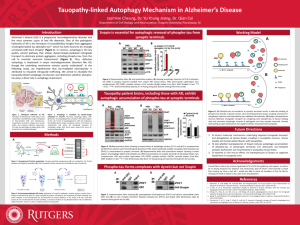Cheung, Jasmine: Tauopathy-linked Autophagy Mechanism in Alzheimer’s Disease
Title: Tauopathy-linked Autophagy Mechanism in Alzheimer’s Disease
Name: Jasmine Cheung
Major: Biological Sciences
School affiliation: Honors College, School of Environmental and Biological Sciences
Programs: Honors in Biology, George H. Cook Scholars Program, Honors College Capstone
Other contributors Qian Cai, Yu Young Jeong
Abstract: Alzheimer’s disease (AD) is a progressive neurodegenerative disorder and the most common cause of late life dementia. One of the pathogenic hallmarks of AD is the formation of neurofibrillary tangles (NFTs), which are composed of hyperphosphorylated tau (phospho-tau), a toxic form of the tau protein. In recent studies, phospho-tau has been found to be better correlated with brain atrophy and memory deficits than beta-amyloid (Aβ), which previously dominated the field of AD research. This new evidence, coupled with the limited success of amyloid-centered clinical trials, has allowed phospho-tau to emerge as a target of interest for further study. In neurons, autophagy is the key quality control pathway that utilizes dynein-Snapin-mediated retrograde transport to eliminate protein aggregates like phospho-tau from the cell to maintain neuronal homeostasis. Thus, defective autophagy is associated with compromised neuron health and has been implicated in major neurodegenerative diseases, though the underlying mechanism remains poorly understood. In this study, we analyzed synaptosomal fractions of phospho-tau-enriched brain tissue to reveal that autophagic retention of phospho-tau at synaptic terminals is a common feature among conditions of tauopathy, including AD. We also provide mechanistic insights into tauopathy-related AD pathogenesis by using co-immunoprecipitation assays to show that phospho-tau directly and specifically associates with dynein motors, leading to interruptions in dynein-Snapin coupling that ultimately result in autophagy dysfunction. While deletion of the snapin gene recapitulates a tauopathy-like phenotype, overexpression of Snapin in tauopathy neurons rescues retrograde transport impairment, thus providing further evidence that synaptic phospho-tau accumulation is attributed to defects in autophagic clearance. By elucidating molecular mechanisms of tauopathy-linked autophagy, we hope to provide critical and novel knowledge towards the development of potential therapeutic strategies for AD and other tauopathy diseases.
